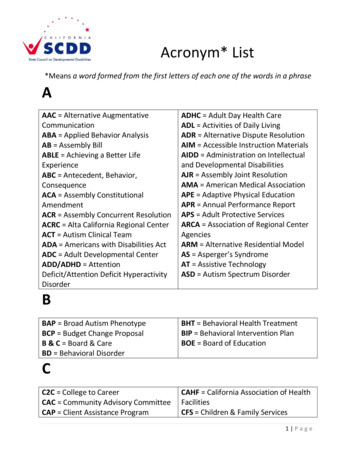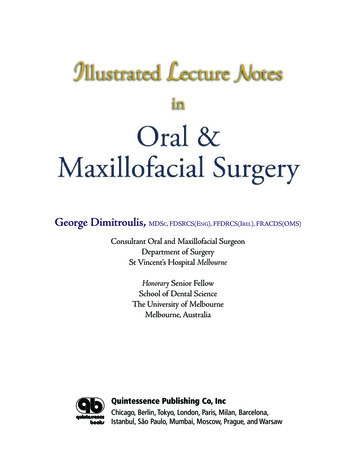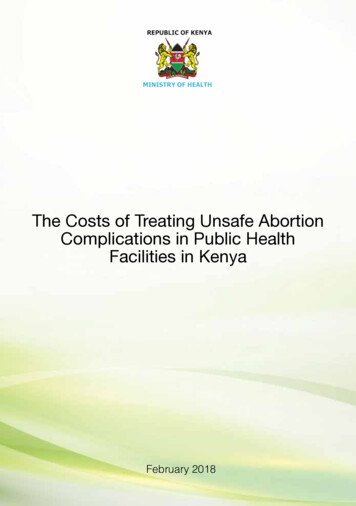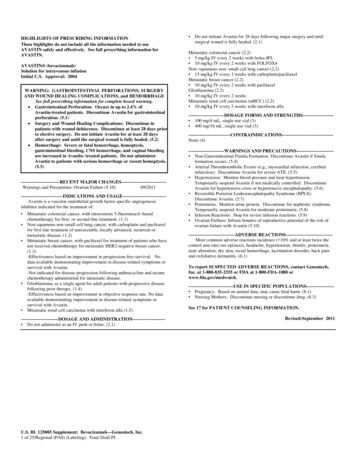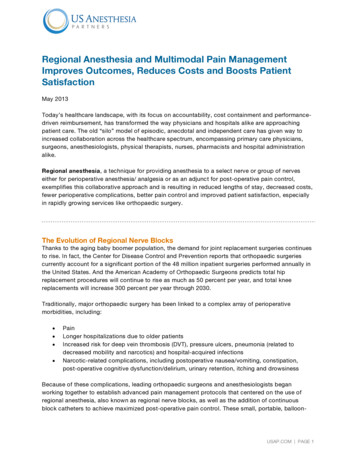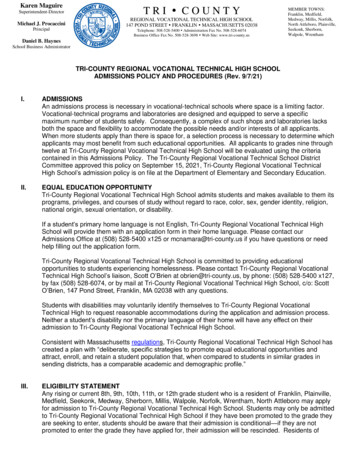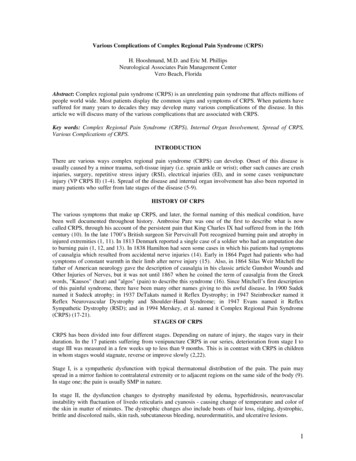
Transcription
Various Complications of Complex Regional Pain Syndrome (CRPS)H. Hooshmand, M.D. and Eric M. PhillipsNeurological Associates Pain Management CenterVero Beach, FloridaAbstract: Complex regional pain syndrome (CRPS) is an unrelenting pain syndrome that affects millions ofpeople world wide. Most patients display the common signs and symptoms of CRPS. When patients havesuffered for many years to decades they may develop many various complications of the disease. In thisarticle we will discuss many of the various complications that are associated with CRPS.Key words: Complex Regional Pain Syndrome (CRPS), Internal Organ Involvement, Spread of CRPS,Various Complications of CRPS.INTRODUCTIONThere are various ways complex regional pain syndrome (CRPS) can develop. Onset of this disease isusually caused by a minor trauma, soft-tissue injury (i.e. sprain ankle or wrist); other such causes are crushinjuries, surgery, repetitive stress injury (RSI), electrical injuries (EI), and in some cases venipunctureinjury (VP CRPS II) (1-4). Spread of the disease and internal organ involvement has also been reported inmany patients who suffer from late stages of the disease (5-9).HISTORY OF CRPSThe various symptoms that make up CRPS, and later, the formal naming of this medical condition, havebeen well documented throughout history. Ambroise Pare was one of the first to describe what is nowcalled CRPS, through his account of the persistent pain that King Charles IX had suffered from in the 16thcentury (10). In the late 1700’s British surgeon Sir Pervcivall Pott recognized burning pain and atrophy ininjured extremities (1, 11). In 1813 Denmark reported a single case of a soldier who had an amputation dueto burning pain (1, 12, and 13). In 1838 Hamilton had seen some cases in which his patients had symptomsof causalgia which resulted from accidental nerve injuries (14). Early in 1864 Paget had patients who hadsymptoms of constant warmth in their limb after nerve injury (15). Also, in 1864 Silas Weir Mitchell thefather of American neurology gave the description of causalgia in his classic article Gunshot Wounds andOther Injuries of Nerves, but it was not until 1867 when he coined the term of causalgia from the Greekwords, "Kausos" (heat) and "algos" (pain) to describe this syndrome (16). Since Mitchell’s first descriptionof this painful syndrome, there have been many other names giving to this awful disease. In 1900 Sudeknamed it Sudeck atrophy; in 1937 DeTakats named it Reflex Dystrophy; in 1947 Steinbrocker named itReflex Neurovascular Dystrophy and Shoulder-Hand Syndrome; in 1947 Evans named it ReflexSympathetic Dystrophy (RSD); and in 1994 Merskey, et al. named it Complex Regional Pain Syndrome(CRPS) (17-21).STAGES OF CRPSCRPS has been divided into four different stages. Depending on nature of injury, the stages vary in theirduration. In the 17 patients suffering from venipuncture CRPS in our series, deterioration from stage I tostage III was measured in a few weeks up to less than 9 months. This is in contrast with CRPS in childrenin whom stages would stagnate, reverse or improve slowly (2,22).Stage I, is a sympathetic dysfunction with typical thermatomal distribution of the pain. The pain mayspread in a mirror fashion to contralateral extremity or to adjacent regions on the same side of the body (9).In stage one; the pain is usually SMP in nature.In stage II, the dysfunction changes to dystrophy manifested by edema, hyperhidrosis, neurovascularinstability with fluctuation of livedo reticularis and cyanosis - causing change of temperature and color ofthe skin in matter of minutes. The dystrophic changes also include bouts of hair loss, ridging, dystrophic,brittle and discolored nails, skin rash, subcutaneous bleeding, neurodermatitis, and ulcerative lesions.1
Due to the confusing clinical manifestations, the patient may be accused of factitious self-mutilation and"Münchausen syndrome (2,23)." All these dystrophic changes may not be present at the same time nor inthe same patient. Careful history taking is important in this regard (2,24).In stage III, the pain is usually no longer SMP and is more likely a sympathetically independent pain (SIP).Atrophy in different degrees is seen. Frequently, the atrophy is overshadowed by subcutaneous edema. Thecomplex regional pain and inflammation spread to other extremities in approximately one-third of CRPSpatients (24-26).At stage II or III it is not at all uncommon for CRPS to spread to other extremities (2,9,22,27). At times, itmay become generalized. The generalized CRPS is an infrequent late stage complication (2,9). It isaccompanied by sympathetic dysfunction in all four extremities as well as attacks of headache, vertigo,poor memory, and poor concentration. The spread through paravertebral and midline sympathetic nervesmay be vertical, horizontal, or both (2, 9, 27-29). The original source of CRPS may sensitize the patient tolater develop CRPS in another remote part of the body triggered by a trivial injury. The ubiquitousphenomenon of referred pain to remote areas (e.g., from foot or hand to spine) should not be mistaken forthe spread of CRPS.At stage III, inflammation becomes more problematic and release of neuropeptides from c-fiber terminalsresults in multiple inflammatory and immune dysfunctions. The secondary release of substance P maydamage mast cells and destroy muscle cells and fibroblasts (30-33).Stage IV identifies the final stage of CRPS manifested by (1, 2): Failure of the immune system, reduction of helper T-cell lymphocytes and elevation of killerT-cell lymphocytes. Intractable hypertension changes to orthostatic hypotension (34). Intractable generalized edema involving the abdomen, pelvis, lungs, and extremities. Ulcerative skin lesions which may respond to treatment with I.V. Mannitol, I.V.Immunoglobulin, and ACTH treatments. Calcium channel blockers such as Nifedipine may beeffective in treatment (35). High risks of cancer and suicide are increased. Multiple surgical procedures seem to be precipitating factors for development of stage IV.Stage IV is almost the flip side of earlier stages, and points to exhaustion of autonomic and immunesystems. Ganglion blocks in this stage are useless and treatment should be aimed at improving the edemaand the failing immune system. Sympathetic ganglion blocks, alpha blockers, including Clonidine, arecontraindicated in stage IV due to hypotension. Instead, medications such as Proamantin (midodrin) arehelpful to correct the orthostatic hypotension (2,36).With passage of time, and types of treatment, CRPS goes through stages with variable time tables andsympathetic responses (5) (Table I).2
Table I. Stages, Signs and Symptoms of CRPSStagesSigns / SymptomsStage I: DysfunctionHyperpathia; allodynia; muscle weakness; flexorspasms; thermal changesEdema; skin; hair and nail changesStage II: DystrophyStage III: AtrophyMuscle atrophy; neurovascular instability; cutaneousrash or skin ulcersSystemic autonomic failure; visceral edema;irreversible low BP; MRSA; elephantiasis; cancerStage IV: Irreversible disturbance of plasticity;autonomic failureVARIOUS COMPLICATIONS OF CRPSMost patients suffer from the standard signs and symptoms of the disease. Over time a majority of patientsthat have suffered for many years to decades do develop various complications of the disease. Over theyears we have recognized a large array of various complications associated with CRPS which often gountreated. Many of these complications are not well recognized by the medical community treating CRPSpatients. However, CRPS continues to be a very complex disease to understand and to treat. These variouscomplications can impede the proper treatment for spread of the disease and the underlying issues that arisefrom these complications.It is very well known that during the long duration of the disease when patients reach stage IV, they start todevelop various complications such as disturbance of the immune system (neurogenic inflammation),limbic system, cardiac system, endocrine system, and the respiratory system. These are just a few of thevarious complications later discussed in this article (1,2,4,7) (Table II).Table II. Various Complications of CRPSAgitationCardiac DisturbanceDepressionDisturbance of Immune SystemDisturbance of JudgmentDysphagiaEndocrine System DysfunctionFatigueGardner Diamond Syndrome(Spontaneous Bruising)Gastrointestinal ComplicationsGERDSHeadaches (Migraine)Hearing ComplicationsHypothyroidismInsomniaInternal Organ InvolvementInterstitial CystitisIntractable HypertensionIrritabilityKeratitis Sicca (Dry Eyes)Limbic System DysfunctionLow Cortisol LevelsMovement DisordersRespiratory System ComplicationsSkin Lesions, Rashes and UlcersSpread of CRPSTinnitusUrological ComplicationsVisual DisturbanceVulvodyniaSPREAD OF CRPSThe spread of CRPS is not usually limited to one part of an extremity or one extremity. Usually, thepathological sympathetic function spreads to adjacent areas (1). CRPS can also spread to the oral facialregion; it causes necrosis (death of cells) of the maxillary and mandibular bones in the areas of the rootcanals.3
In the late stages of CRPS, due to prolonged immobilization, or improper treatment such as unnecessarysurgery or application of ice, the disease shows a tendency to spread.The spread may be vertical from arm to leg (or vice versa) on the same side or may be horizontal from armto arm or leg to leg. The spread which occurs in about one third of patients is more likely to develop aftersurgical procedure (1,2,9,21,37-42).The mechanism of spread is due to the fact that at the level of the spinal cord the sympathetic input has atendency to cross the midline to the opposite side. The second reason for spread is a chain of relay stationsof the sympathetic nerves in the form of sympathetic ganglia on each side of the spine (42).The main reason for the CRPS becoming bilateral and spreading to other extremities is because in contrastto the somatic nervous system, the sympathetic nervous system has bilateral innervation. In the somaticnervous system (usual sensation and motor function) the abnormalities in dermatome in a specific nerveroot distribution, whereas in CRPS the abnormality is distributed among the blood vessels, distribution ofnerves (thermatomes) and to the sympathetic ganglia and their across the midline collections, the conditionreflects itself on both sides rather than one side of the body. This bilateral manifestation through thesympathetic plexi across the midline explains the patient's problem with headache, dizziness, tinnitus, chestpain, and abdominal manifestations of CRPS (gastritis, diarrhea, cramps) and spread of CRPS to otherextremities.INTERNAL ORGAN COMPLICATIONSCRPS invariably involves the internal organs. Usually the skin surface is cold at the expense of increasedcirculation to the internal organs. This increased circulation can cause osteoporosis, fractures of bone,abdominal cramps and diarrhea, disturbance of absorption of foods with resultant weight loss, waterretention with aggravation of premenstrual headaches and depression, persistent nausea and vomiting, aswell as severe vascular headaches mistaken for "cluster headache".In addition, CRPS can cause the complication of intractable hypertension which responds best to alpha Iblockers (Dibenzyline, Hytrin, or Clonodine). CRPS can cause attacks of irregular or fast heart beat, chestpain, coronary artery spasm (angina), as well as disturbance of function of other internal organs. A fewexamples are frequency and urgency of urination, respiratory disturbance such as dyspnea and apneicattacks, and attacks of severe abdominal pain.Attacks of swelling of the internal organs complicated by intermittent constriction of the blood vessels todifferent organs can result in chest pain, attacks of sharp central pain (stabbing severe pain in the chest orabdomen), and changes in voice (suddenly developing a temporary "chipmunk" type of voice change). Thesharp, stabbing, central pain can be helped with treatment with medications such as anticonvulsant(Tegretol or Neurontin).The internal organs complication may become aggravated by traumatic effect of sympathetic nerve blocks.One such complication is accidental trauma to the kidney with resultant hematuria (blood in urine) andaggravation of hypertension.Because of the above complex phenomenon, in CRPS the sympathetic nerves follow the path of the bloodvessels rather than somatic nerve roots resulting thermotomal rather than dermatomal sensory nervedistribution (mistaken for hysterical sensory loss) may cause a complex clinical picture that baffles theclinician and forces the clinician to blame the patient as being hysterical, hypochondriac, and blaming theserious warning signs of CRPS complications as "functional and not organic".The end result is the deadly phrase "it is all in your head" which practically almost all CRPS patients havehad to deal with in the course of their treatment. The patient's symptoms and signs are real and they are notfigment of their imagination.4
The treating physician needs to take the time to learn and understand that the sympathetic system iscomplex, bilateral and diffuse.Both Doctors Schwartzman and Veldman have reported that CRPS Type I and II are systemic disease thatcan affect any organ system (7,43).IMMUNE SYSTEM COMPLICATIONSThe sympathetic system regulates the immune system. The sympathetic system is responsible for control ofbody temperature, control of vital signs and control of the immune system. Any kind of stress thatstimulates the sympathetic system also stimulates the immune system.In the first two years after the development of CRPS, the immune system is up regulated with high T celllymphocytes causing low grade fever, neurodermatitis, trophic ulcers, spontaneous bruising, edema,clinical pictures of compression (entrapment), and neuropathies such as so-called carpal tunnel syndromeand thoracic ulcer syndrome, which can easily be corrected with conservative treatment rather than surgicaltreatment.After two years, as the CRPS becomes chronic and the healing power (plasticity) of the nervous system andimmune system becomes disturbed. The patient develops hypoactive, down regulated immune system withdevelopment of permanent elevation of killer T cell lymphocytes, suppression of helper T celllymphocytes, and development of persistent skin pathology, such as persistent edema involving theparaspinal and upper and lower extremities. The patient also develops persistent pruritus andneurodermatitis, persistent trophic ulcers, spontaneous bruising, permanent dystrophic changes in regard toskin healing, and abnormal hair and nail growth.CRPS is due to dysfunction of the sympathetic nervous system. The sympathetic nerves function in adynamic fashion - at times being hyperactive and at other times being hypoactive. This is in regard tocontrol of circulation and control of the immune system. From day to day the sympathetic control ofcirculation may fluctuate. This is usually in the form of neurovascular instability, meaning one day thehand or foot is bluish red, and the next day it is so white it looks like it is dead. The immune system controlmay undergo up-regulation or down regulation: one day the patient is feverish, and the next day the patientis "ice cold".NEURO-INFLAMMATION COMPLICATIONSThe sympathetic system has three main functions:1. Thermal regulation.2. Control of vital signs (blood pressure, pulse and respiration).3. Control of the immune system.All three functions are essential for preservation of milieu interne. The neuroinflammation is aphysiopathologic response of the body against any stressor. Neurodermatitis of emotional stress, edema ofthe extremity in CRPS, profuse skin ulcers in venipuncture CRPS II (3), sterile osteonecrosis involving thefacial bone or bones in the extremities, and modulation of the T-cell lymphocytes in late stages ofneuropathic pain and CRPS are some of the examples of neuro-inflammation. The sympathetic systemshows a uniform response to a stressor be it infectious, traumatic, emotional, or prolonged inactivity. If theneuro-inflammation is not properly diagnosed and treated, the patient will end up with unnecessarysurgeries for carpal tunnel, tarsal tunnel, or thoracic outlet syndrome. The trauma of surgery secondarilyinitiates a new round of more severe neuro-inflammation, edema, and entrapment.5
Neuro-inflammation is the key to understanding the hyper-and hypothermic spots in Infrared ThermalImaging (ITI). Peripheral nerve injury causes vasoconstriction distally, and vasodilation in thecorresponding paravertebral nerve regions.This hyperthermic vasodilation in the paraspinal regions is due to transmission of substance P (SP) andnitric oxide (NO), and other neurokines from periphery to the spinal cord.Prolonged neurokine transmission and accumulation at paraspinal nerves distribution causes neck pain, lowback pain, headache, and vertebral arteries constriction secondary to vertigo, falling attacks, and blurredvision.Of these four principle manifestations of CRPS (pain, movement disorder, inflammation, and insomnia) theinflammation manifests itself in several different forms. This may be in the form of simple swelling of theextremities, joint pain, skin rash, blotching or cyanosis, trophic changes such as hair loss or fingernailsdegeneration, black and blue spots without any trauma to the skin, bleeding under the skin, and persistentitching.Epidural and paravertebral nerve blocks correct this condition. However, any type of trigger point or nerveblock injection should be done proximally rather than distally in the area of pathology. Any needleinsertion in the distal portion of the extremity will add more trauma and aggravation of the neuropathic painand vasoconstriction.The inflammatory aspect of the CRPS is just as disabling as the pain or movement disorder.MOVEMENT DISORDER COMPLICATIONSMovement disorders are common in most CRPS patients (1,44) (Figures 1 and 2). As, Schwartzman hasemphasizes “the movement disorder is frequently ascribed to hysteria and pain” (45).Figure 1. CRPS and movement disorder of the left foot, ankle, and toes.6
Figure 2. CRPS and movement disorder of the right hand, wrist and fingers.Myoclonic jerks are common forms of movement disorder in CRPS (2). In 38 of our 824 patients sufferingfrom CRPS due to spinal cord injury, myoclonic jerks were invariably noted. In addition, myoclonic jerkswere present in 44 of 63 CRPS patients secondary to electrical injury (2,44,46,47). This may be due toelectricity going through the path of least resistance (afferent c-fibers) and secondarily originating spinalcord dysfunction (1,2,46).In, Schwartzman and Kerrigan’s study of 200 patients with RSD, subtle dystonia and movement disorderwere seen in 10 patients (48).In studies reported by Jankovic, movement disorders in CRPS have been accompanied by tremor anddystonia (1,49,50).Also, Blümberg and Jänig have reported tremor and other movement disorders in more than 80% of CRPSpatients (51). Veldman, et al. has noted movement disorder in 95% of 829 patients (43). In our series of 824patients, the incidence was 78% (2).Cervicogenic CRPS in rare cases can cause tremor in the hand and forearm, and in some cases it can besevere enough to cause writer’s cramps and illegible handwriting. This complication of CRPS is morecommonly seen after traumatic adjustment of the cervical spine (1).LIMB DEFORMITY COMPLICATIONSLimb deformity is another complication seen in some CRPS cases. Patients with limb deformity had anaverage lag time of 22.3 months delay between the onset of the disease and the first diagnosis of CRPS.This was in contrast with the non-deformity patients who had a lag time of 14.5 months between the onsetand diagnosis.The patients with limb deformity were treated with ice or hot and cold challenge for an average of 4.6months versus the patients with no deformity for an average of 3.1 months. In both groups, the hypothermiatherapy was usually discontinued due to the persistent protestation of the patient against ice treatmentbecause of aggravation of pain.CRPS-I (RSD) versus CRPS-II (Causalgia) categories: There was no statistical difference between the twocategories in regard to the incidence of complication of limb deformity. However, the causalgic groupdeveloped the limb deformity earlier in the course of the disease. The average lag time between trauma andthe development of the deformity in CRPS-II (causalgia) group was 7 months.The risk factors contributing to the development of limb deformity consist of surgical procedures,exploratory operative procedures (such as looking for neuroma or looking for entrapment neuropathy),immobilization with cast or wheelchair, and prolonged use of cryotherapy (application of ice). Thedeformity evolved earlier in the CRPS-II (Causalgic) group than in the CRPS-I (RSD) group.7
LIMBIC SYSTEM COMPLICATIONSThe neuropathic pain of CRPS is regional, and its polysynaptic sensory fibers terminate bilaterally in thelimbic system (52). This explains the symptoms of insomnia, agitation, irritability and depression in CRPS(2,53) (Figure 3) (Tables III and IV).Practically every patient suffering from CRPS demonstrates some degree of limbic system disturbance.These patients are expected to be depressed in more than 3/4 of the cases, anxious in practically every oneof the cases, and to suffer from insomnia, agitation, irritability and poor judgment in practically every oneof the cases. These manifestations are one of the four criteria for the diagnosis of CRPS. There is no waythe limbic system can be left intact in the face of CRPS.Figure 3. The afferent somatosensory nerves terminate in the contralateral parietal somatosensory cortex. In contrast, theunmyelinated c-fiber thermosensory nerves through synaptic relays terminate in bilaterally in limbic frontal temporale regionsresponsible for mood, memory and judgment. This explains the emotional disturbance, and insomnia in CRPS. With permission fromCRC Press Publishers. (1).Table III. Pain Perception1. Somatic (Simple, Common Pain)Parietal Cortex2. Sympathetic (Neuropathic)3. Bilateral Limbic System/Anterior Frontal Temporal Lobes (52)8
Table IV. CRPS Components1. Sensory Burning Pain2. Motor: Cold Extremity Tremor/Flexor Spasm (38,54)3. Inflammation: Swelling, Skin Rash, Bruising of the Skin, Osteoporosis,Fractures, Fluid in Joints4. Limbic System Dysfunction (Emotional Control Centers of Temporaland Frontal Lobes): Insomnia, Agitation, Depression, and Poor Judgment.CARDIAC COMPLICATIONSIn our clinic we have seen many CRPS patients who have developed cardiac complications. Chest pain dueto CRPS is quite common due to the fact that the cardiac sympathetic plexus surrounding the heart is a richsympathetic nerve structure, and its dysfunction can cause severe chest pain.CRPS causes three independent negative influences on cardiac function.1. The sympathetic system is responsible for three main functions, i.e., temperature regulation, vital signs,and regulation of the immune system. The vital signs in the form of heart beat, blood pressure andrespiration are up regulated and accelerated by stimulation of the sympathetic system. The CRPS is not asimple hyperactivity only stimulation of the sympathetic system. It is the result of dysfunction of thesympathetic system. This dysfunction shows instability of the sympathetic system at times causingfluctuation of blood pressure and at other times causing attacks of fast heart beat.2. The second reason CRPS affects cardiac function is due to the anatomical innervation of the heartmuscles. Of all the visceral organs, the heart has the richest innervation of the sympathetic system. This isin the form of cardiac plexus which is a rich plexus of nerves surrounding the heart. In any stressfulcondition, the natural response is rapid heart beat and rise of the blood pressure. The CRPS being adistressful type of dysfunction of the sympathetic system, results in repetitive pathological and exaggeratedresponse of the sympathetic system to stress, chest pain, palpation, and bouts of high blood pressure.3. One of the main principles of development of CRPS is inflammation. CRPS is a condition with fourmajor features. First, the allodynia and hyperpathia is typical with pains seen with sympathetic dysfunction.Second, is motor response to such pain in the form of vasoconstriction, muscle spasm and muscle tremor.Thirdly, inflammation in the form of skin rash, swelling of soft tissues in the extremities, increasedcirculation in the visceral structures resulting in osteoporosis, pelvic inflammation, and attacks of vascularheadaches. The same inflammation and increased visceral circulation causes distress on the heart.Obviously if the patient has already had pre-existing cardiac disease, the distressful disease of CRPS isgoing to cause further stress on the heart on the basis of the above mentioned three principles.Another symptom that we have seen associated with the cardiac complications of CRPS is a rash across thepatient’s chest wall.Rasmussen and colleagues have reported that atypical chest pain is a common complaint in 94 % of CRPSpatients (6,55).Smith and colleagues published an article reporting that pre-syncope and syncope are complications inlower limb CRPS patients. These symptoms are related to autonomic dysfunction. In their study theyreported 40% of CRPS patients showed symptoms of pre-syncope and syncope (56).Unfortunately, cardiac complications of CRPS go unnoticed and the patients are blamed as being neuroticespecially due to the fact that many CRPS patients are young and they have no coronary artery disease.9
SKIN LESIONS AND SKIN RASH COMPLICATIONSA few years after onset of CRPS, the patient can develop neurodermatitis, trophic ulcers, Gardner-DiamondSyndrome (GDS) (spontaneous bruising), and skin rashes (6,57,58).Doctor Goris has reported that 5% of patients with long-standing CRPS develop various skin problems thatare very difficult to heal (59).Trophic ulcers are not unusual in CRPS, being a sympathetic nervous system dysfunction, it manifests itselfas follows:1. Hyperpathic and allodynic pain (pain accompanied by change in vital signs, sweating and pain thatbecomes worse with simple touch or a breeze).2. The response to the pain is in the form of motor response the spinal cord resulting in constriction ofblood vessels, cold extremities, and muscle spasm, tremor and flexion deformity.This disturbance of the immune system manifests in inflammation, spontaneous bruising and black andblue spots over the skin, neurodermatitis, edema and swelling that mimic conditions such as carpal tunneland tarsal tunnel syndrome. In addition, the immune system disturbance in more severe cases not onlycause neurodermatitis, but also causes trophic ulcers. Trophic ulcers usually develop after treatment withcast immobilization, wheelchair immobilization, surgical treatment or application of ice. At, times, thetrophic ulcer and immune system disturbance are caused by incomplete pain management (Figure 4).Figure 4. CRPS patient suffered for many years with severe lesions on both hands and arms. Treatment with I.V. Mannitol helped healthe lesions.10
INFECTION COMPLICATIONSInfections are another complication that is seen in advanced end stage of CRPS. In our clinic we have seen12 patients who had end stage CRPS who ultimately had to have an amputation due to severe infectionsand edema (Figures 5 and 6).Figure 5. CRPS of seven years duration due to right hand injury. Two years of unsuccessful operations of right carpal tunnel, and 5years of immobilization of hand have resulted in "Boxer’s Hand Deformity" and ultimate amputation (2).Figure 6. Twenty-Three years after onset of CRPS due to a car accident. The patient suffered from infections for over a year and half.I.V. and oral antibiotics were unsuccessful in treating the infections. Ultimately the left leg was amputated above the knee (A.K.A).The patient in (Figure 5) suffered for seven years due to a hand injury. With two years of impropertreatment, unsuccessful surgeries for carpal tunnel on the right hand and five years of immobilization ofhand resulted in the patient developing a "Boxer’s Hand Deformity"(2). After years of suffering the patientultimately had to have the hand and arm amputated.The patient in (Figure 6) developed CRPS in his left foot, ankle and toes after a car accident at age 20. Thepatient was misdiagnosed for 2 ½ years. During that time he did not receive any proper treatment. For thefirst three years after onset the patient was still able to walk on a painful deformed extremity which was aresult of a movement disorder. In the third year after the onset of CRPS the patient had undergone anunsuccessful fusion surgery of the left great toe which caused spread of disease up the leg and into thetrunk area. After the surgery the patient had lost the use of his left leg for over twenty years.11
In the twenty-first year after onset of the disease the patient had severe relapsing infections in the left footand toes. The patient suffered for a year and a half with these very painful infections. He was treated for ayear and a half with oral and i.v. antibiotics that were unsuccessful in treating the infections.In, the twenty-third year after onset of CRPS the patient had to ultimately undergo a two-stage above theknee amputation (AKA) of the left foot and leg. The patient’s amputation was considered successful due tothe fact that he has been able to use a prosthetic (a c-leg) and learn how to walk again after not walking ontwo feet for over twenty plus years.It has been over 30 years now since the patient’s onset of CRPS and it’s been 7 ½ years since the patient’samputation. He still suffers from some of the symptoms of CRPS in his residual limb and
H. Hooshmand, M.D. and Eric M. Phillips Neurological Associates Pain Management Center Vero Beach, Florida Abstract : Complex regional pain syndrome (CRPS) is an unrelenting pain syn drome tha t affects millions of people world wide. Most patients display the common signs and symptom s of CRPS. When patients have
